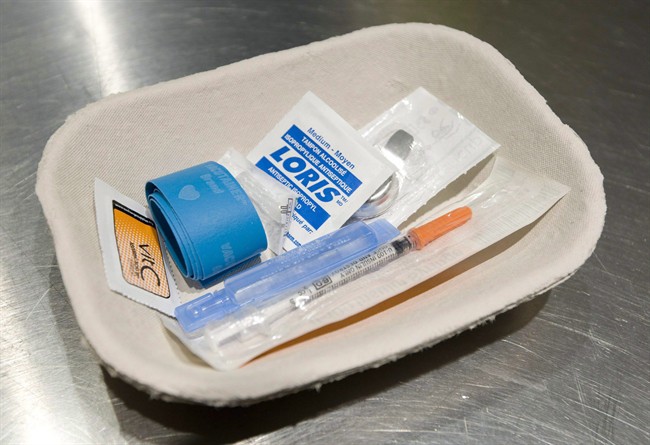At the end of June, Alberta’s Drumheller Institution, a medium-security federal prison, is set to become the first prison in the country to open an overdose prevention site where inmates can consume their drugs under medical supervision.

While the pilot program is being praised by medical and drug policy experts as a positive measure to curb rising overdoses behind bars, correctional officers are wary of being forced to acknowledge — and even accept — that illicit drugs are being consumed on their watch.
“The philosophy that has been given to us by the government of Canada is that they’re there, and inmates need a safe way to inject them,” Jeff Wilkins, national president of the Union of Canadian Correctional Officers, told Global News. “To us, honestly, the resources should be put into keeping drugs out of prison.”
READ MORE: Alberta prison staff member charged with drug trafficking at Drumheller Institution
The Correctional Service of Canada (CSC) received an exemption from Health Canada to open an overdose prevention service at Drumheller Institution by the end of the month, a CSC spokesperson told Global News in an email. CSC oversees more than 50 federal prisons, which house inmates serving sentences of two years or more.
“An overdose prevention service would add to CSC’s efforts to help prevent the sharing of needles among inmates, limit the transmission of infectious diseases, facilitate referrals to health-care services and programs and prevent fatal and non-fatal overdoses,” the spokesperson wrote, adding that discussions with unions and staff regarding the site are ongoing.
LISTEN BELOW: Alberta prison opens first overdose prevention site for inmates in Canada
Overdoses and overdose deaths in federal prisons have more than doubled in recent years, according to a 2019 report by Corrections Canada. Drumheller, located more than an hour from Calgary, often has the highest overdose rates.

Get weekly health news
Harm reduction advocates have called for an expansion of naloxone and medication-assisted treatment for inmates with addictions as well as other measures such as needle exchanges. Switzerland opened the first prison needle exchange program in 1992, and it also has at least one prison supervised consumption site.
Wilkins said his corrections officers prefer overdose prevention sites to needle exchange programs, which he said endanger guards by putting syringes in the hands of inmates. Corrections Canada has rolled out needle exchange programs in at least five of its prisons since 2018. The program, aimed to reduce the spread of infectious diseases, will eventually be implemented at all remaining prisons.
Earlier this year, about two dozen workers from the Grand Valley Institution for Women in Kitchener protested the needle exchange at the facility and called for a supervised consumption site instead.
WATCH: Peterborough frontline workers alarmed by spike in opioid overdoses

The Drumheller overdose prevention site will be opened on June 24, said Wilkins, and it will be overseen by health-care workers and not corrections officers. He said that inmates would use their own drugs there and would not be provided with any.
“When it comes to the current program that they have right now with the prison needle exchange, it does nothing to prevent overdoses. It puts it on the backs of correctional officers. We’re the ones that are going in the cell to try to revive the inmate who’s overdosed. At the very least, an overdose prevention site is being moderated by a health-care professional,” said Wilkins.
As with federal prisons, overdose rates have also been rising in provincial jails, which typically house inmates awaiting trial or who have been sentenced to less than two years in custody. They are run by the province and not CSC. Last month, at least seven inmates are believed to have died of an overdose during the span of one week at a provincial jail in Hamilton, Ont.
Chris Jackel, who represents provincial correctional officers with the Ontario Public Service Employees Union, told Global News he would not support an overdose prevention site in Ontario provincial jails.
“Quite frankly, I think it’s a ridiculous idea. And I can’t believe any government is entertaining it,” said Jackel. “We have inmates who are in our custody; a lot of them are known drug users. We should not be affording them an opportunity to use drugs.”
READ MORE: 1 dead and 5 injured after suspected drug overdoses at Milton prison
Jackel said he would support empowering corrections staff to keep drugs out of the facilities altogether. This could include increasing searches, expanding the use of ion scanners for inmates and all mail and increasing the use of drug-sniffing dogs.
“Let’s increase addictions counselling and treatment in our institutions,” he said. “That, to me, is the proactive approach.”
Dr. Lori Regenstreif is a clinical professor of family medicine at McMaster University who has worked as a physician in Hamilton’s provincial jail and has volunteered at the city’s overdose prevention site.
“You can never keep fentanyl out of the jails. Good luck with that,” Regenstreif told Global News. “The amounts are so tiny. There’s no way you can control that kind of substance at that kind of potency.”
READ MORE: How lethal opioids devastated a small region of Ontario
She said that providing harm reduction and health care in a provincial system differs from the federal system as the inmates are there for shorter periods of time. That makes it easier for a federal facility to have an overdose prevention site and for inmates to access addictions treatment.
Regenstreif said that corrections officials can try to keep substances out of the institution while also providing harm reduction services and treatment options to inmates who continue to use. She called the Drumheller overdose prevention site “compassionate.”
“It’s not just about keeping people from overdosing but it’s also giving them positive interactions with health-care providers so they might feel safer disclosing that they have a problem,” said Regenstreif. “Hearing about this reflects already a change in culture, which I feel optimistic about.”









Comments